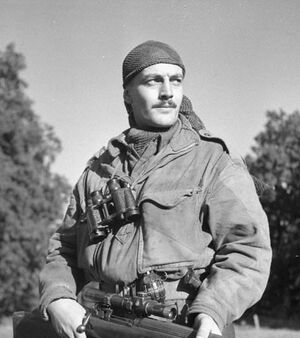Marcus Nykvist
Marcus Nykvist | |
|---|---|
 | |
| Born | 15 March 1912 Västermyrriset, Västergötland, Acrea |
| Died | 2 June 2006 |
| Allegiance | |
| Service/ | Royal Acrean Army |
| Years of service | 1930-1972 |
| Battles/wars | Great Eracuran War |
| Awards | see below |
Marcus Madsson Nykvist was an Acrean sniper and officer during the Great Eracuran War. Considered the most successful sniper in the history of the Acrean Army, Nykvist is officially credited with killing 652 enemy soldiers during his service on the Shalumite front of the war from 1940-1945. First deployed as an advisor to the Shalumite Army in 1940, Nykvist took part in many of the major defensive actions fought by the Shalumite Army during that part of the war, with his high tally often credited to the favourable circumstances for snipers in the dense, ruined urban terrain of Shalumite cities like Valemur where heavy fighting took place.
Nykvist remained in the army after the war, becoming director of the Royal Acrean Army Sniper School at Rynningeviken in 1950. Reforming the curriculum based upon the temporary sniper school he helped establish in Shalum during the war, Nykvist was instrumental in reforming Acrean Army doctrine on the use of snipers in large-scale ground warfare.
Early life
Nykvist was born in Västermyrriset in the Duchy of Västergötland to a well educated, middle-class family. His mother was a nurse while his father, a veteran of the Kunhegyes Conflict, was an attorney and part of the board of the local hunting club. Nykvist learned marksmanship while hunting with his father and his father's friends, and took up hunting and fieldcraft as a hobby during his youth. Although initially desiring to go into legal studies to follow his father's profession, Nykvist was convinced by a close friend to enlist.
Military service
Nykvist joined the Royal Acrean Army in 1930 as a volunteer, enlisting with a guaranteed officer training slot due to his high test scores and a letter of recommendation from his regional parliamentary representatives. During basic training, his marksmanship and bushcraft skills caught the attention of instructors. Following the completion of training, he was offered a slot to go to the Sniper School at Rynningeviken, which had been established in 1918. Nykvist immediately accepted the opportunity despite having to give up his slot for officer training to do so. By all existing accounts, Nykvist performed well at the school, and graduated in February 1931.
After graduation, Nykvist was assigned to the 6th Infantry Division based in Savigny in the Duchy of Côte-d'Or. Speaking only conversational French from his lessons in school, he was paired with his primary spotter, Odette Courtemanche, one of the first formally trained female snipers in the Acrean Army. In 1934, Nykvist applied for and attended officer training, obtaining his commission in November. He and several other snipers were subsequently re-assigned to serve as part of the Acrean observer corps studying the Siduri War. Nykvist himself took strong interest in the Ruvelkan military and Resistance, who used sharpshooters extensively in comparison to other fighting forces in the conflict. His reports back to Acrea contained substantial discussion on Ruvelkan marksmen operating in cities and other urban terrain.
When he was recalled back to Acrea in 1937, Nykvist immediately began work with instructors and other observers on integrating the lessons from Siduri into the school's curriculum. He would remain working as an instructor at the school until 1939, when Nykvist was recalled to his division. He volunteered to go to Shalum when Acrea began sending military advisers in early 1940, and along with a cadre of 15 other snipers, was integrated with a Shalumite infantry division. Fighting and living alongside their Shalumite counterparts, Nykvist helped to train Shalumite sharpshooters in the field.